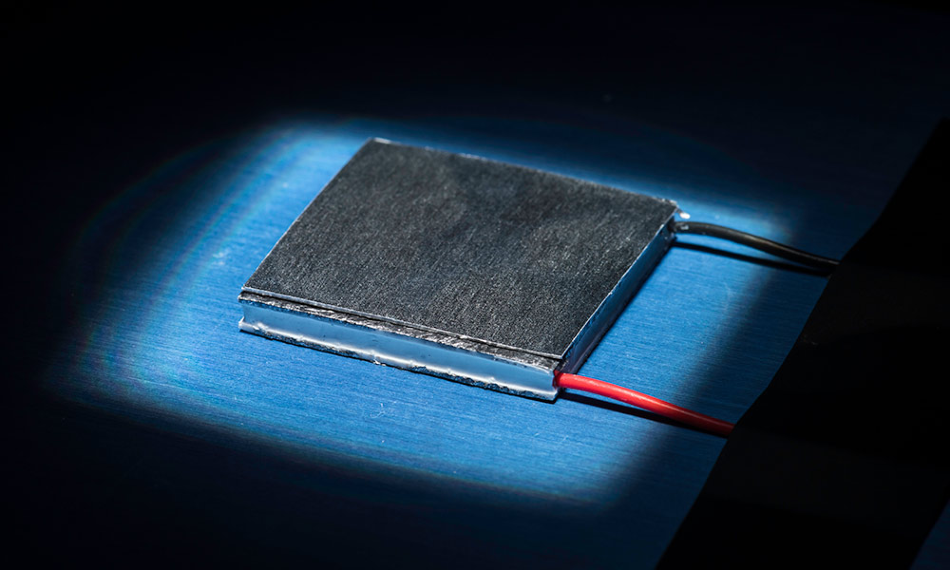Feb 5 2020
The research laboratory at the University of Rochester has demonstrated a new laser-based technique to create highly efficient solar power generators using unsinkable metallic structures. The research laboratory had recently utilized lasers to produce these unsinkable metallic structures.
 Rochester professor Chunlei Guo and his team have developed a technique that can be used to collect sunlight to heat etched metal surfaces like the one featured here, which can then power an electrical generator for solar power. Image Credit: University of Rochester photo/J. Adam Fenster.
Rochester professor Chunlei Guo and his team have developed a technique that can be used to collect sunlight to heat etched metal surfaces like the one featured here, which can then power an electrical generator for solar power. Image Credit: University of Rochester photo/J. Adam Fenster.
In a study published in Light: Science & Applications, the laboratory of Chunlei Guo, professor of optics and also affiliated with the Department of Physics and Astronomy and the Material Sciences Program, has described how strong femtosecond laser pulses can be used to etch the surfaces of metals with nano-structures that selectively take in light only at the solar wavelengths and not elsewhere.
A standard metal surface is highly reflective and shiny. In the past, the laboratory of Chunlei Guo created a black metal technology that made shiny metals appear pitch black.
But to make a perfect solar absorber. We need more than a black metal and the result is this selective absorber.
Chunlei Guo, Professor of Optics, Department of Physics and Astronomy, University of Rochester
This metal surface not only improves the absorption of solar energy but also decreases the dissipation of heat at other wavelengths, practically, “making a perfect metallic solar absorber for the first time,” added Guo. “We also demonstrate solar energy harnessing with a thermal electric generator device.”
“This will be useful for any thermal solar energy absorber or harvesting device,” specifically in places that have abundant sunlight, Guo further added.
The study was financially supported by the National Science Foundation, the Bill and Melinda Gates Foundation, and the Army Research Office.
The scientists experimented with tungsten, steel, copper, and aluminum, and observed that among these elements, tungsten had maximum solar absorption efficiency when it was treated with the novel nanoscale structures.
This enhanced the efficiency of generating thermal electricity by as much as 130% when compared to untreated tungsten. Tungsten is often utilized as a thermal solar absorber.
The study’s co-authors are Sohail Jalil, Bo Lai, Mohamed Elkabbash, Jihua Zhang, Erik M. Garcell, and Subhash Singh from Guo’s laboratory.
A Long Line of Research
In addition, the laboratory has successfully produced superhydrophilic (water-attracting) and superhydrophobic (water-repellent) metals using the femtosecond laser etching technology.
For instance, in November 2019, Guo’s laboratory reported the development of metallic structures that do not sink, even if they are constantly pushed into water or extensively punctured or damaged.
But the latest study expands upon the initial work of the laboratory with black metal etched with a femtosecond laser. Before producing the water-repellent metals and water-attracting metals, Guo and his assistant, Anatoliy Vorobyev, showed how femtosecond laser pulses can be used to change virtually all kinds of metals pitch black.
The surface structures, thus produced on the metal, captured the incoming radiation, like light, most effectively. However, these structures captured light across a wide range of wavelengths.
Later, Guo’s research team employed an analogous process to convert the color of different metals into different colors, like gray, golden, and blue, apart from the black that was already accomplished.
Such applications can lead to the development of optical spectral devices and color filters or a car factory that uses a single laser to create different colors of cars. The applications can also help in etching a family’s full-color photograph onto the refrigerator door or proposing with a gold engagement ring that corresponds with the blue eyes of an individual’s fiancee.
In addition, the laboratory utilized the initial black-and-colored-metal method to produce a special range of microscale and nanoscale structures on the surface of a standard tungsten filament, thereby allowing a light bulb to shine more brightly at the same consumption of energy.
We fired the laser beam right through the glass of the bulb and altered a patch on the filament. When we lit the bulb, we could actually see this one patch was clearly brighter than the rest of the filament.
Chunlei Guo, Professor of Optics, Department of Physics and Astronomy, University of Rochester
Soaking up the sun with laser treated metal
Video Credit: Matthew Mann/University of Rochester.